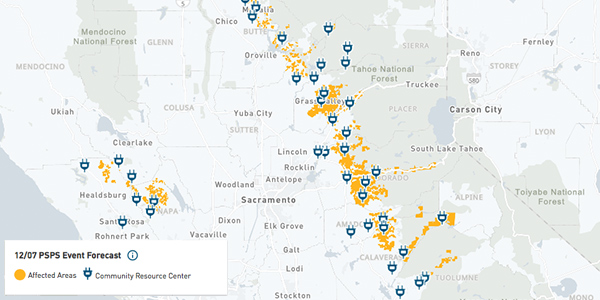Pacific Gas and Electric canceled forecasted blackouts Monday after saying it might shut off power to nearly 400,000 residents to prevent wildfires. The move would have been an extraordinary step in December, when fire season is normally over in the utility’s Northern California service territory.
Over the weekend, Southern California Edison and San Diego Gas & Electric instituted public safety power shutoffs (PSPS) in their service territories that affected roughly 85,000 customers, or nearly 250,000 residents, as hot dry Santa Ana winds created dangerous fire conditions.
PG&E predicted mass blackouts Friday, a day after the California Public Utilities Commission unanimously approved the utility’s 2020-2022 general rate case. The decision included a nearly $1.3 billion, three-year rate increase, much of it meant to help the utility prevent wildfires and limit the extent of PSPS events.
“This decision provides significant funding for PG&E’s Community Wildfire Safety Program,” Commissioner Liane Randolph said. “The CWSP incorporates a risk-based approach to identify and address PG&E assets that are most at risk from the threat of wildfires and associated events.”
The CPUC approved $603 million in 2020, $930 million in 2021 and $1.5 billion in 2022 in total funding for the wildfire program. PG&E said it will use the funds for enhanced vegetation management and system hardening, including installing stronger poles and trimming branches from an estimated 120 million trees.
The commission authorized a $9.1 billion revenue requirement for PG&E in 2020, a $584 million increase over 2019 but $474 million less than the utility’s initial request. Increases of $316 million and $364 million for 2021 and 2022, respectively, will follow. PG&E and consumer groups reached the final amounts in a settlement approved by the CPUC.
Randolph noted that nearly $3 billion of PG&E’s wildfire mitigation work is excluded from its rate case by Assembly Bill 1054, passed last year. The bill prohibits the state’s three large investor-owned utilities from earning a return on equity for their combined share of the first $5 billion spent on wildfire-prevention measures.
The CPUC also approved a settlement provision that allows PG&E to recover up to $1.4 billion in annual insurance costs.
The settlement and commission’s decision followed 17 community meetings held throughout PG&E’s service territory and four weeks of evidentiary hearings.
The utility’s equipment started devastating fires in 2017, 2018 and 2019 that killed more than 100 residents and destroyed tens of thousands of structures, the California Department of Forestry and Fire Protection found. The department is investigating PG&E for starting another wildfire in September that killed four people and burned more than 200 structures in rural Northern California. (See PG&E Under Scrutiny in Deadly Zogg Fire.)
In a recent letter, CPUC President Marybel Batjer threatened to institute a new process of increased oversight of PG&E for what she said were serious lapses in the utility’s vegetation management. (See related story, PG&E Faces ‘Enhanced Oversight’ by CPUC.)
Critics have said the company put shareholder profits over grid maintenance for decades.
“Unfortunately, this summer has showed us again that PG&E is still behind in the investments needed to … make [its] system and vegetation management safe,” Commissioner Martha Guzman Aceves said. She said she would support PG&E’s rate increase for safety reasons despite it coming during a pandemic and economic downturn, when many residents will feel the increase more.
December Fire Conditions
In its initial PSPS statement last week, PG&E said it might shut off power to 130,000 customers — or about 377,000 residents, based on average household size — in parts of 15 counties.
“Dry conditions combined with expected high wind gusts pose an increased risk for damage to the electric system that has the potential to ignite fires in areas with dry vegetation,” the utility said in a news release.
It reduced the number Saturday to 92,000 customers, or about 267,000 residents, after receiving updated weather forecasts. It then cut the number of customers potentially affected by 90% Sunday and canceled the blackouts altogether Monday, citing improved weather.
In a separate statement on its rate case, PG&E said the CPUC’s decision will allow it to keep future PSPS events smaller and shorter.
The late fall fire conditions also impacted dryer Southern California, which has had catastrophic fires in December in recent years. The blazes included the 2017 Thomas Fire, blamed partly on Southern California Edison equipment. (See Edison Takes Partial Blame for Wildfire in Earnings Call.)
SCE said Monday it had shut off power to about 12,000 customers for safety reasons and was considering shutting off power to more than 193,000 others, as the Santa Ana winds whipped wildfires in its service territory.
San Diego Gas & Electric blacked out 73,000 customers on Friday during dry, windy conditions. It had restored power to most by Monday but said more than 50,000 customers remained at risk for PSPS.
During the CPUC’s discussion of PG&E’s rate case, commissioners said climate change was pushing fire season later in the year and affecting greater numbers of residents.
“We are in the midst of customers facing shutoffs now because these … dry winds are continuing into December, beyond what has been our usual fire season,” Commissioner Genevieve Shiroma said.



